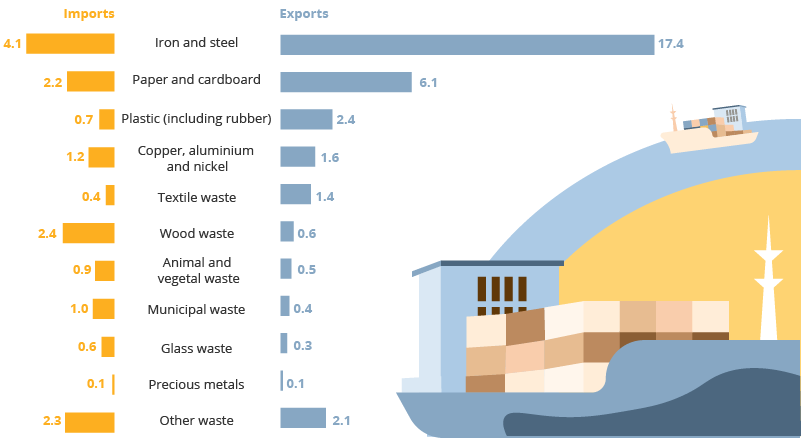Waste Signal 1: Waste shipments
EU waste legislation is partially designed around the proximity principle, which implies that the EU should have adequate capacity to treat its own waste and avoid exporting waste — which may lead to more pollution — to third countries. The EU Waste Shipment Regulation (EC, 2020) restricts waste exports outside the EU’s borders (see Figure 1).

Notes: Mt = million tonnes.
Source: EEA (2022).
Although more than 90% of the waste generated in the EU is treated domestically, significant amounts are still exported to other countries. Iron and steel are the most prominent materials in waste imports into the EU as well as exports from it (see Figure 2). These shipments are almost exclusively composed of non-hazardous materials and are mostly exported for recycling. However, there have been indications that, in many instances, waste shipped for treatment outside the EU is not optimally managed (EC, 2020). This potentially creates more pollution than if the waste were to be managed within the EU.

Source: EC (2021a).
The European Commission is revising the Waste Shipment Regulation (EC, 2021b) to address this issue and introduce measures for the proper management of exported waste. These measures aim to ensure that waste is managed in an environmentally sound way by both exporting companies and importing countries. However, a knowledge gap remains around the conditions and technologies applied to exported waste.
References
EEA, 2022, Linking cross-border shipments of waste in the EU with the circular economy, European Environment Agency (https://www.eea.europa.eu/publications/linking-cross-border-shipments-of) accessed 18 October 2022.
EC, 2020, Commission staff working document on the evaluation of Regulation (EC) No 1013/2006 of the European Parliament and of the Council of 14 June 2006 on shipments of waste (SWD(2020) 26 final) (https://ec.europa.eu/environment/pdf/waste/shipments/SWD_2020_26_F1_SWD_EVALUATION_EN_V4_P1_1064541.pdf) accessed 18 October 2022.
EC, 2021a, Commission staff working document ‘Impact assessment accompanying the document Proposal for a regulation of the European Parliament and of the Council on shipments of waste and amending Regulations (EU) No 1257/2013 and (EU) No 2020/1056’ (SWD(2021) 331 final) (https://eur-lex.europa.eu/legal-content/EN/TXT/?uri=CELEX%3A52021SC0331&qid=1642757230360) accessed 18 October 2022.
EC, 2021b, Proposal for a new regulation on waste shipments, European Commission, Brussels (https://environment.ec.europa.eu/publications/proposal-new-regulation-waste-shipments_en) accessed 18 October 2022.
Waste Signal 2: Industrial symbiosis as a way to reduce waste generation
Industrial symbiosis is a way of reusing materials that are by-products of industrial processes for other uses. It is a form of industrial waste prevention that has the potential to alleviate waste generation (which is itself a source of pollution).
The potential of industrial symbiosis to prevent waste is significant in terms of both volume and financial value (EC, 2018; see Figure 1). Some specific industrial sectors have more potential for such activities than others; moreover, logistical considerations can determine the final costs and benefits of implementing industrial symbiosis. For heavier waste streams such as construction and demolition waste, industrial symbiosis can take place only locally because of high transport costs; conversely, for high-value waste materials such as metals, transport costs are low compared with the waste value.

Source: EC (2018).
Click here to view the figure enlarged
Industrial symbiosis diverts waste from landfills and alleviates primary natural resource extraction, both of which reduce pollution. One of the most cited examples is in Kalundborg, Denmark, where 200,000 tonnes of fly ash (a hazardous waste material derived from landfilling), 200,000 tonnes of gypsum and 2,800 tonnes of sulphur extraction were avoided thanks to industrial symbiosis (Rahman et al., 2016). These materials were used as feedstock in neighbouring plants to replace primary resource use, further reducing the overall environmental impact.
Although industrial symbiosis can have positive effects, it also may potentially use hazardous waste, resulting in the release of such substances into the environment. Careful processing and monitoring is needed to ensure that the potential environmental impacts are effectively managed.
References
EC, 2018, Cooperation fostering industrial symbiosis: market potential, good practice and policy actions: final report, Publications Office of the European Union, Luxembourg (https://data.europa.eu/doi/10.2873/346873) accessed 18 October 2022.
Rahman, M.F., et al., 2016, ‘Industrial Symbiosis: A review on uncovering approaches, opportunities, barriers and policies’, Journal of Civil Engineering and Environmental Science, 2(1), pp. 011-019 (https://www.peertechzpublications.com/Civil-Engineering-Environmental-Sciences/pdf/JCEES-2-109.pdf).
Cover image source: © Mateo Puđa, Well with Nature /EEA


Document Actions
Share with others